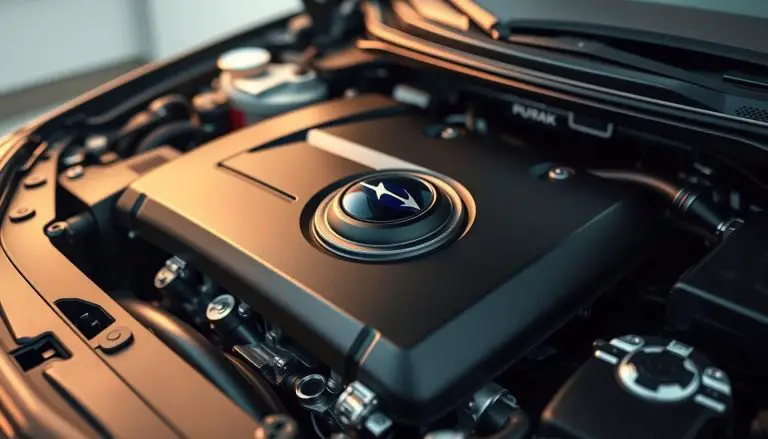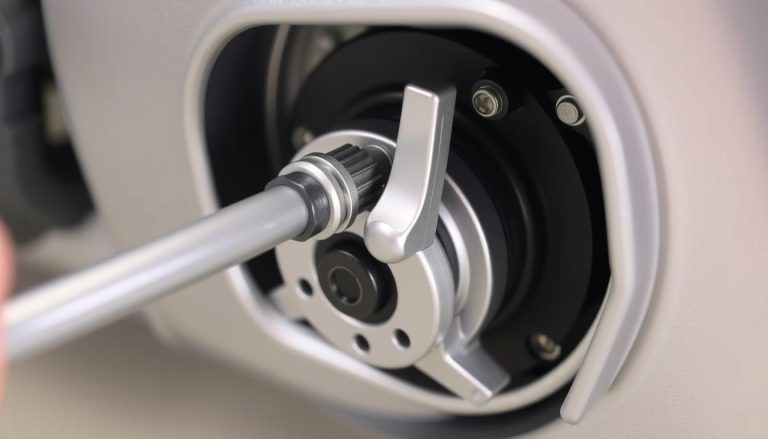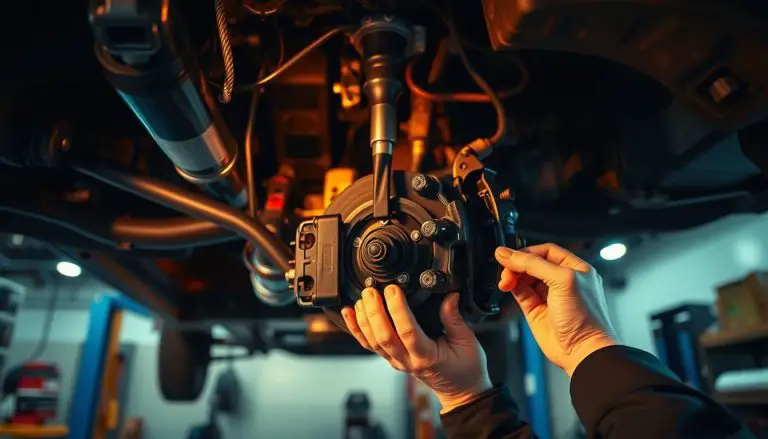This introduction outlines clear, practical guidance for checking and topping off the transmission fluid on your chrysler 300, and for deciding when a full fluid change is needed.
Start by confirming whether adding fluid will fix the issue. Check the level with the engine running and at the correct temperature. Use the dipstick tube or check plug to add slowly and avoid overfill.
Always follow the exact type listed in the owner’s manual—labels like Dexron, Mercon, Allison, Type-F, or CVT matter. Using the wrong product can shorten transmission life.
This guide explains how to read the dipstick, when a quick top-off works, when a full transmission fluid change is better, and when it’s wiser to visit a trusted shop for warranty or safety reasons.
Key Takeaways
- Verify the level with the engine running and at proper temperature.
- Use the exact fluid type from the manual or approved equivalent.
- Top off slowly through the dipstick tube to avoid overfill.
- A half-quart top-up can fix minor hesitation or clunky shifts.
- Measure drained fluid to approximate service fill vs full capacity.
- Choose a professional shop when warranty or complex service is needed.
Chrysler 300 Transmission Fluid Capacity and Specifications
Identify the exact automatic unit in your vehicle to pick the correct oil amount and spec.
Capacity varies by model year and the automatic used. Always confirm whether your sedan has the NAG1 unit or a different family before ordering oil or planning a refill.
NAG1 example (2005–2008)
For the 2005–2008 model with NAG1, full capacity is 8.0 liters (about 8.45 quarts). A typical service fill after a pan drop and filter change is roughly 5.0 liters (≈ 5.28 quarts).
Approved fluid and equivalents
The OEM listing for NAG1 shows Shell 3404. Approved analogs include synthetic DEXRON III/VI and MERCON, but always match the manual for your exact year and powertrain.
| Transmission | Full (L) | Service (L) | Common Spec |
|---|---|---|---|
| NAG1 (2005–2008) | 8.0 | 5.0 | Shell 3404 / DEXRON III/VI |
| 42LE / 41TE / 62TE | Varies | Varies | Mopar ATF+4 |
| 5‑45RFE | Varies | Varies | Mopar ATF+4 |
Note: Pan drops do not remove all oil; measure drained amount to guide refill and avoid overfill.
How to Check and Add Transmission Fluid on a Chrysler 300
Begin by parking on flat ground, setting the brake, and letting the engine warm to get an accurate dip reading.
Prep and safety: Make sure the engine is running and the car is level. Set the parking brake. Use the correct dipstick or check plug for your model so the stick markings match the service chart.
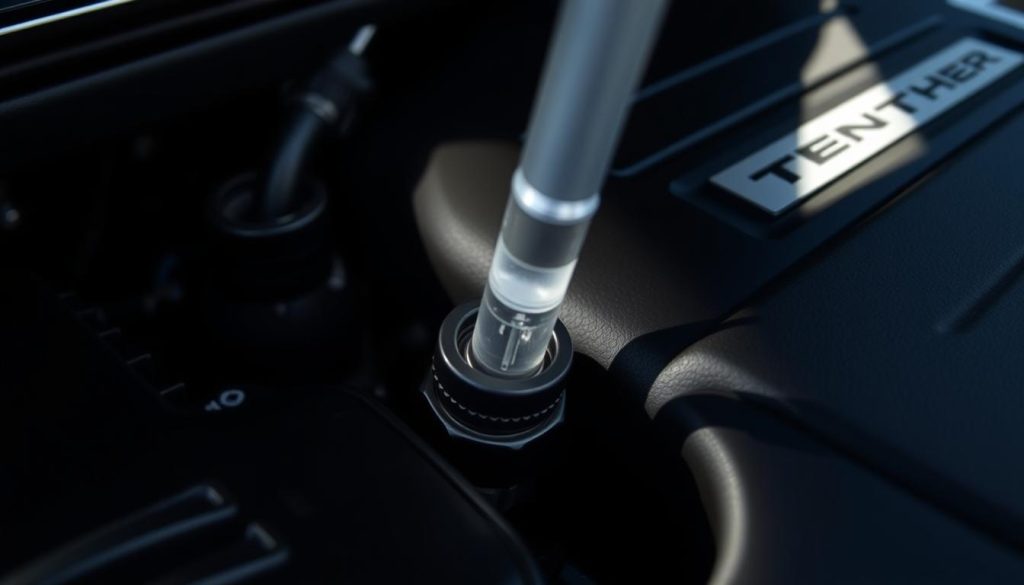
Checking the transmission fluid level
Wipe the dipstick, reinsert, then pull it again to read the hot marks. Temperature affects the reading, so follow the hot/cold hashes on the stick.
Shift through all gears with your foot on the brake, return to Park, then recheck the stick. If the level reads low, you may only need a small amount—sometimes a half quart fixes hesitation.
Adding fluid safely
Add transmission fluid slowly through the dipstick tube or the check plug opening. Pause between small pours so the fluid can settle and the stick can register the new level.
Go slow. Overfilling is hard to correct and can harm the unit.
Choosing the right product
Always use the spec listed in the owner’s manual. Look for approved ATF labels and brand notes to match friction characteristics. If you want tips on a hard-to-read dipstick, see hard-to-read dipstick tips.
Tip: After adding, recheck level twice—once after warm-up and again after cycling gears—to confirm there are no leaks causing a low reading.
| Step | Action | Why it matters |
|---|---|---|
| 1 | Park level, engine running | Ensures accurate transmission fluid level reading |
| 2 | Wipe, reinsert, read dipstick | Avoids false readings from surface residue |
| 3 | Add slowly via dipstick tube | Prevents overfill and internal pressure issues |
| 4 | Use OEM spec ATF | Maintains proper friction and shift behavior |
Transmission Fluid Change: Step-by-Step Service Guide
Prepare a clean workspace and the right parts before any pan removal begins.
Tools and parts: Gather a new fluid filter, pan gasket, correct ATF, torque wrench, replacement bolts if needed, a large drain pan, funnel, jack and stands. Confirm factory torque specs and have safety gear handy.
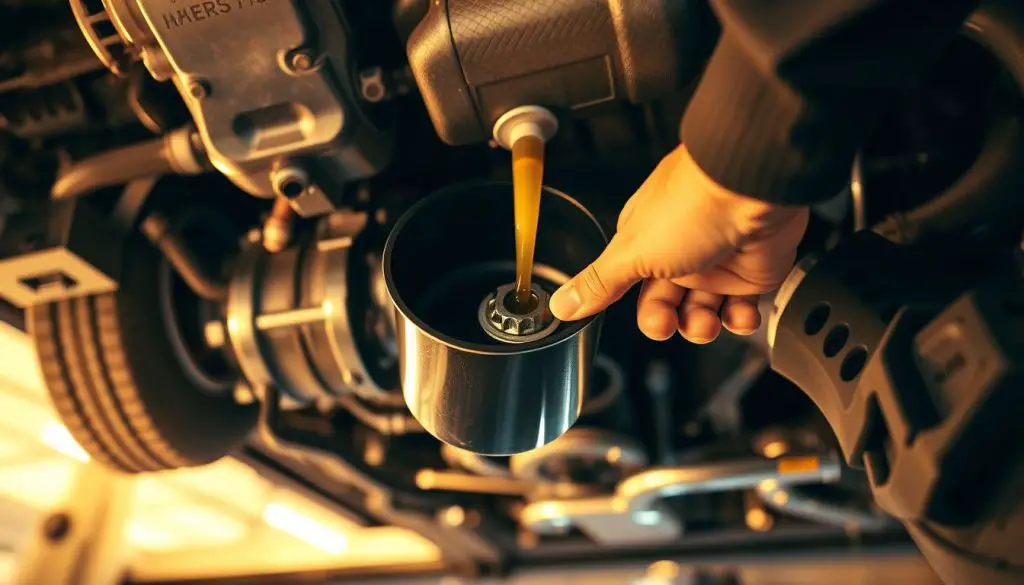
Draining the old oil
Safely raise and support the vehicle. Loosen pan bolts gradually so the oil pan tilts and drains without splashing. Collect and note the drained amount to guide refill.
Replacing the filter and pan gasket
Remove the old filter, clean the pan and magnet, and seat the new filter. Fit the pan gasket, start bolts by hand, then tighten in a cross pattern to the factory torque to avoid distortion and leaks.
Refill amounts and measuring
Use the drained volume as a baseline if exact specs are unknown. For the NAG1 example, a service fill after pan drop is about 5.0 liters (≈ 5.28 quarts); full fill is ~8.0 liters (≈ 8.45 quarts).
Final checks and maintenance timing
Start the engine, cycle each gear, return to Park, and recheck the level on the dipstick. Top off in small increments to reach the hot mark without overfill.
Plan a fluid change by miles and years, and watch for dark color, burnt smell, or slipping as signs it’s time. If you lack tools or space, visit a shop to ensure correct torque and a clean seal.
Tip: Measure how much you drained and refill that same amount as a safe starting point, then fine-tune using the dipstick.
| Task | Key action | Why it matters |
|---|---|---|
| Gather parts | Filter, pan gasket, ATF, torque wrench | Prevents delays and wrong fluid use |
| Drain pan | Loosen bolts gradually, collect oil | Controls spill and records amount drained |
| Reinstall pan | Hand-start bolts, torque in cross-pattern | Prevents leaks and pan distortion |
| Refill & check | Refill service amount, run engine, recheck dipstick | Ensures correct level and shift quality |
Conclusion
Short, frequent checks of the level and measured adds will save time and reduce the chance of overfill.
Staying on top of transmission fluid maintenance is the best way to preserve smooth shifting and extend component life in your car. If the owner’s manual lacks a clear fill number, refill the same oil amount you drained, then fine-tune to the hot mark on the dipstick.
Use the correct ATF, take your time during service, and plan changes by miles and years. When unsure, consult a trusted shop. Also check coolant and other underhood fluids while you work—community posts and experienced members often share helpful, model-specific tips.
FAQ
What is the correct transmission fluid amount and service fill for a 2005–2008 300 with the NAG1 automatic?
The full fill for the NAG1 (also known as the 42RLE/45RFE family alternative in some markets) is roughly 9–10 liters (about 9.5–10.5 quarts) with the torque converter included. A service fill after a pan drain typically requires 4–5 liters (about 4.2–5.3 quarts). Always check the owner’s manual for the exact figure for your model year and verify using the dip stick or check plug and correct temperature when measuring.
Which ATF types are approved and what are equivalent fluids to match the owner’s manual?
Use the OEM-specified ATF listed in your owner’s manual—commonly a fully synthetic, manufacturer-approved automatic transmission fluid meeting the listed spec (for example, ZF or Mopar-approved equivalents where referenced). Quality aftermarket brands with the correct spec and ATF label compatibility are acceptable, but avoid generic or off-spec oil. When in doubt, consult dealership service literature or the parts department.
How should I prepare and stay safe before checking or adding transmission oil?
Park on a level surface and set the parking brake. Use wheel chocks and jack stands if lifting the vehicle. For dipstick checks, warm the engine to the temperature the manual specifies, usually idling in park or neutral. Use gloves and eye protection when working under the pan or near the drain, and keep a drain pan and rags handy to catch spills.
What’s the correct way to check the fluid level using the dipstick, and why does temperature matter?
With the engine warmed to the specified temperature, shift through the gears then return to Park or Neutral, keep the engine idling, and pull the dipstick from the tube. Wipe it, reinsert fully, then remove and read the level against the hot range marks. Fluid expands when hot; checking cold will give a lower reading and can lead to overfill if you add without warming first.
How do I add transmission oil without overfilling—dipstick tube or check plug method?
Add fluid slowly through the dipstick tube using a funnel or pump, or through the check plug if equipped. Add small amounts, wait a minute for the fluid to settle, then recheck the level. Overfill can cause foaming, overheating, and shifting problems, so go slow and use the proper temperature range on the dipstick.
What tools and parts do I need for a typical service: pan gasket, filter, and drain?
Typical tools: ratchet and socket set, torque wrench for correct bolt torque, drain pan, jack and stands, funnel, and a pump for refill. Parts: new filter, pan gasket, and the correct volume of ATF. Have replacement pan bolts or washers handy if the service manual recommends them.
How do I drain old oil and manage the amount removed during a pan service?
Remove the pan bolts and lower the pan carefully into a drain pan to capture fluid. Expect to remove the fluid in the pan plus a portion that remains in the torque converter and cooler lines. Measure the drained amount so you can approximate refill needs: service fill will normally be the drained amount plus a small margin per the manual.
What’s the correct process for replacing the filter and pan gasket and torquing bolts?
Remove the old filter, clean the sealing surface, install the new filter per the manual, and replace the pan gasket. Tighten bolts in the recommended sequence and to the specified torque values to prevent leaks and warping. Use a new pan gasket and replace any damaged bolts or seals.
How do I refill to the proper level after a filter and pan change—service fill vs. full capacity?
Refill with the measured drained amount plus the service-fill quantity recommended for your model. Start the engine, cycle through gears, then check the level at operating temperature and add slowly until it reaches the hot range on the dipstick. Full capacity (including torque converter) is only reached after a full drain and refill procedure or when a cooler line flush is performed.
What final checks should I perform after changing the oil and filter?
Start the engine, let it reach operating temperature, shift through all gear positions to circulate fluid, then recheck the level and top off as needed. Inspect the pan gasket and bolt areas for leaks and verify proper driveability — smooth shifts, no slipping or odd noises. Re-torque bolts if the service manual requires a follow-up check.
How often should I change the transmission oil—miles, years, and service signs?
Follow the owner’s manual schedule, often every 60,000–100,000 miles for many modern automatics, earlier in severe service. Change sooner if you notice dark, burnt-smelling fluid, slipping gears, delayed engagement, or contamination. Regular inspections and filter changes extend transmission life.
Can I add fluid myself or should I take the vehicle to a shop?
Homeowners can add fluid and perform a pan/filter service if comfortable with basic mechanical work and have the right tools. Use jack stands, a torque wrench, and follow the manual. For full flushes, cooler line services, or diagnosing shifting problems, a professional shop or dealer visit is advisable.
How do I find the dipstick tube and what if my model doesn’t have a dipstick?
The dipstick tube sits near the back of the engine bay and is labeled or shaped to accept a long dipstick. Some late-model units have a sealed system without a dipstick; those use a check plug under the vehicle and require a level check at temperature with the car on ramps or a lift.
Are there common mistakes to avoid during a fluid change or level check?
Avoid overfilling, using the wrong ATF type, skipping filter or gasket replacement, and checking level when the fluid is cold. Also don’t rely on estimates—measure what you drain, follow torque specs, and verify level at the correct temperature to prevent leaks, foaming, or transmission damage.
Where can I get exact capacity and spec info for my specific model year and engine?
Consult the vehicle owner’s manual, factory service manual, or contact a dealership service department for accurate, model-year-specific specifications. Online parts retailers and OEM parts catalogs also list approved fluid types and capacity figures for each VIN or model-year variation.
